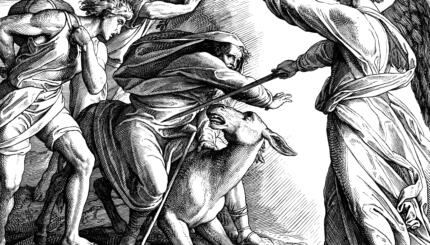Commentary on Parashat Terumah, Exodus 25:1 - 27:19
This week’s Torah portion and Haftarah [reading from the Prophets] are an exercise in counterpoint. Superficially, the construction of sacred space joins them in a common theme. While the Torah portion takes up the erection of the Tabernacle in the wilderness, the narrative from the book of Kings recounts the building by Solomon of the First Temple in Jerusalem some 480 years later.
The move is from a mobile sanctuary to a permanent one, from wood to stone. Still, the basic design remains the same, an oblong structure with the Holy of Holies (devir) at the rear, farthest away from the entrance. Likewise, the content of the Holy of Holies is unaltered: an ark covered by two large cherubim with outstretched wings. The ark itself contained only the two tablets which attested to the covenant between God and Israel sealed at Mount Sinai.
Of greater interest to me is what separated these two cultic centers. They enjoyed vastly different levels of popular support. Both institutions reflect God’s will. In the case of Moses, the instructions are given directly, orally and visually (Exodus 25:9, 40; 26:30; 27:8). In the case of David, the sanction comes from God (II Samuel 7), the execution is left to Solomon. Yet the contrast could not be greater, and herein lies the value of the juxtaposition.
Helping Build the Tabernacle
The Torah highlights the fact that the people as a whole volunteer their possessions and services to build the Tabernacle. God enunciates the ideal at the outset: “Tell the Israelite people to bring Me gifts; you shall accept gifts for Me from every person whose heart so moves him” (25:2). By implication, should they fail to contribute, the project would be delayed, if not aborted. And later the narrative stresses their extraordinary degree of compliance. The occasion stirred both men and women to share equally and unstintingly of their valuables and handiwork for the glory of the sanctuary. Indeed, contributions flowed in at such a furious pace that word had to be issued to end the campaign (Exodus 36:5-6).
The Torah leaves little doubt that the building of the Tabernacle was a consensual enterprise. The people’s enthusiastic response to Moses’s call for contributions translated into action the verbal assent they had given at Mount Sinai at hearing the content of the covenant: “Then he took the record of the covenant and read it aloud to the people. And they said,’All that the Lord has spoken we will faithfully do!'” (24:7). Their faith was the wellspring of their philanthropy.
The mode by which Solomon carried out the construction of his Temple stands in stark contrast. The proportions of the project seemed to savage the idealism that brought the Tabernacle to fruition. There is no trace of voluntarism in Solomon’s financing scheme. To pay for the cedar and cypress wood provided by the King of Tyre and to quarry and transport the building materials, Solomon took recourse to a massive levy. Our Haftarah relates:”King Solomon imposed forced labor on all Israel; the levy came to 30,000 men. He sent them to Lebanon in shifts of 10,000 a month…Solomon also had 70,000 porters and 80,000 quarriers in the hills, apart from Solomon’s 3,300 officials who were in charge of the work” (I Kings 5:27-30). In short, participation was not tendered freely but harshly coerced.
The difference did not escape the attention of a medieval midrash. “The Tabernacle for which the people volunteered wholeheartedly never fell victim to the evil eye. The Temple, however, for which they did not, fell victim to the hand of the enemy” (Kasher, Torah Shlemah, v.20, p. 6). Thus, the fate of an institution is determined by the measures taken to create it. A polity cannot long survive without popular support. Solomon’s Temple rested on shaky ground. Not only was centralizing the sacrificial cult in Jerusalem (that is, forbidding all sacrifices outside the Temple) are volutionary step, but it also saddled the citizens of his recently united realm with heavy taxation. Little wonder that the kingdom immediately split apart after his death.
Lessons of the Tabernacle
The lasting lesson of the Tabernacle is the supreme importance of voluntarism in the conduct of the Jewish polity. The twin values of tzedakah and gemilut hasidim–of charity and deeds of lovingkindness–combined to make of voluntarism the communal ethos. In the medieval Jewish community that spirit manifested itself in a network of voluntary associations, havurot, each with its own mission, such as burying the dead, visiting the sick, promoting adult education or aiding the poor. The impulse to create an association was usually a specific mitzvah, the benefit to the individual member, a licit form of socializing and the consequence to the community, a means of meeting its multiple needs. This ethos of public service is what enabled Jews in the absence of a state to forge a polity that was almost wholly self-sufficient.
The virtue is singled out in a special prayer, misheberakh, which we recite in the synagogue right after the reading of the haftarah. We ask God to bless all those who serve the public weal, “by uniting to establish synagogues for prayer, and entering them to pray, and giving funds for heat and light, and wine for Kiddush and Havdalah, bread to the wayfarer and charity to the poor, and devoting themselves always to the needs of this community and the Land of Israel.”
The prayer is a marvelous instance of the manner in which the synagogue contributes to the formation of social capital. The liturgy turns values into prayers which function as an instrument of public education. Behavior we deem worthy of God’s favor should become a goal for our own lives.
The boundless organizational vitality of the American Jewish community springs from this same spirit of voluntarism. While the endless details of the building of the Tabernacle may drive us to distraction, we should not lose sight of the selfless ethos that drove the project to completion. Salvation in Judaism is about losing ourselves in the welfare of the whole and making a difference in the lives of others.
Provided by the Jewish Theological Seminary, a Conservative rabbinical seminary and university of Jewish studies.
ark
Pronounced: ark, Origin: English, the place in the synagogue where the Torah scrolls are stored, also known as the aron kodesh, or holy cabinet.
Torah
Pronunced: TORE-uh, Origin: Hebrew, the Five Books of Moses.
Haftarah
Pronounced: hahf-TOErah or hahf-TOE-ruh, Origin: Hebrew, a selection from one of the biblical books of the Prophets that is read in synagogue immediately following the Torah reading.



